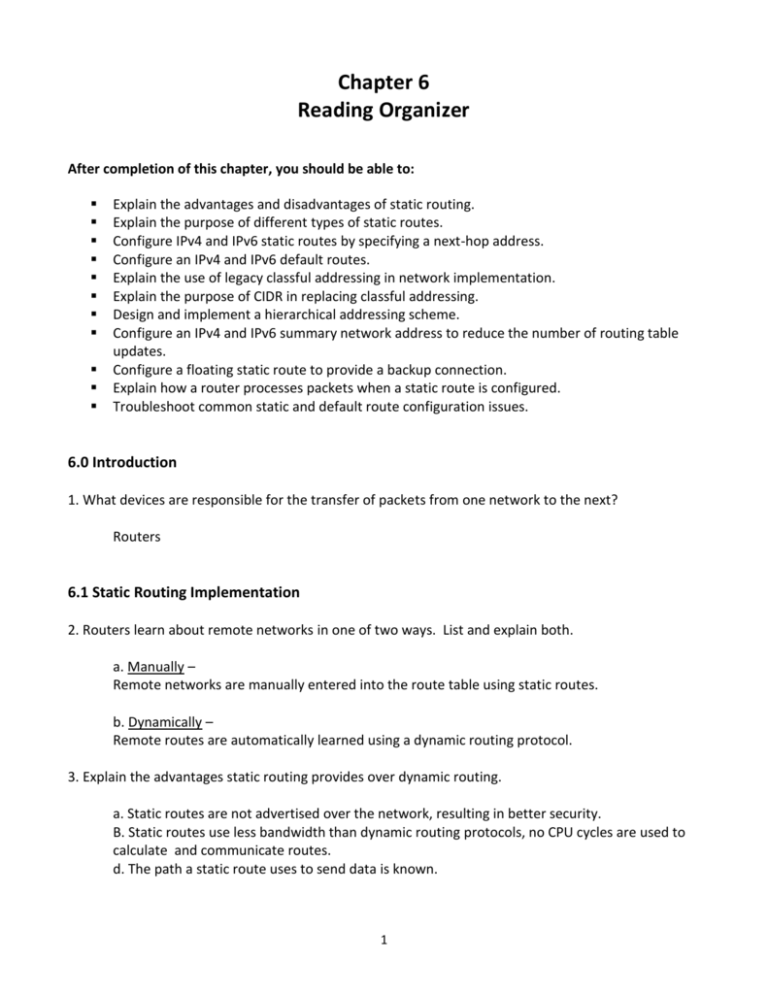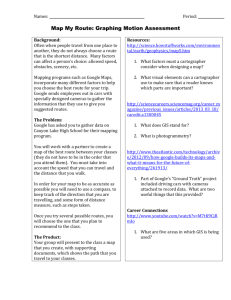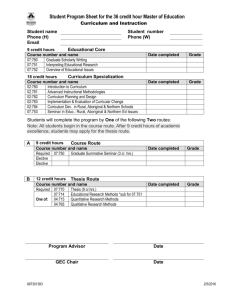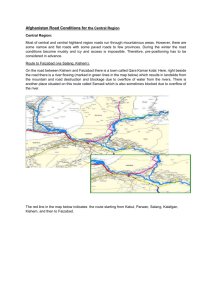Chapter 06 - Reading Organizer
advertisement

Chapter 6 Reading Organizer After completion of this chapter, you should be able to: Explain the advantages and disadvantages of static routing. Explain the purpose of different types of static routes. Configure IPv4 and IPv6 static routes by specifying a next-hop address. Configure an IPv4 and IPv6 default routes. Explain the use of legacy classful addressing in network implementation. Explain the purpose of CIDR in replacing classful addressing. Design and implement a hierarchical addressing scheme. Configure an IPv4 and IPv6 summary network address to reduce the number of routing table updates. Configure a floating static route to provide a backup connection. Explain how a router processes packets when a static route is configured. Troubleshoot common static and default route configuration issues. 6.0 Introduction 1. What devices are responsible for the transfer of packets from one network to the next? Routers 6.1 Static Routing Implementation 2. Routers learn about remote networks in one of two ways. List and explain both. a. Manually – Remote networks are manually entered into the route table using static routes. b. Dynamically – Remote routes are automatically learned using a dynamic routing protocol. 3. Explain the advantages static routing provides over dynamic routing. a. Static routes are not advertised over the network, resulting in better security. B. Static routes use less bandwidth than dynamic routing protocols, no CPU cycles are used to calculate and communicate routes. d. The path a static route uses to send data is known. 1 4. Explain the disadvantages of static routing. a. Initial configuration and maintenance is time-consuming. b. Configuration is error-prone, especially in large networks. c. Administrator intervention is required to maintain changing route information. d. Does not scale well with growing networks; maintenance becomes cumbersome. e. Requires complete knowledge of the whole network for proper implementation. 5. Do most networks use dynamic routing protocols, static routes, or a combination of both? A combination of both 6. The administrative distance (AD) of a static route is 1. Which type of route will take precedence, a static route or dynamically learned routes? Static Route 7. What are the three primary uses for static routing? a. Providing ease of routing table maintenance in smaller networks that are not expected to grow significantly. b. Routing to and from stub networks. A stub network is a network accessed by a single route, and the router has only one neighbor. c. Using a single default route to represent a path to any network that does not have a more specific match with another route in the routing table. Default routes are used to send traffic to any destination beyond the next upstream router. 8. Check the correct option to show if the static routing descriptors are an advantage or disadvantage of static routing. 2 9. Static routes can be used to do what? a. Connect to a specific network b. Connect a stub router c. Summarize routing table entries d. Create a backup route They can also be used to: e. Reduce the number of routes advertised by summarizing several contiguous networks as one static route f. Create a backup route in case a primary route link fails 10. What does a default route identify? The gateway IP address to which the router sends all IP packets that it does not have a learned or static route. 11. Explain when default static routes are used: 3 a. When no other routes in the routing table match the packet destination IP address. In other words, when a more specific match does not exist. A common use is when connecting a company's edge router to the ISP network. b. When a router has only one other router to which it is connected. This condition is known as a stub router. 12. To reduce the number of routing table entries, multiple static routes can be summarized into a single static route if: a. The destination networks are contiguous and can be summarized into a single network address. b. The multiple static routes all use the same exit interface or next-hop IP address. 13. What is the primary purpose of a floating static route? Floating static routes are static routes that are used to provide a backup path to a primary static or dynamic route, in the event of a link failure. 14. What is necessary to set up a floating static route so it doesn’t override the default route? To accomplish this, the floating static route is configured with a higher administrative distance than the primary route. 15. Determine the correct static route type based on each description. 6.2 Configure Static and Default Routes 16. Identify the parts of the static route shown below. 4 17. The next hop can be identified by an IP address, exit interface, or both. How the destination is specified creates one of the three route types. List and explain each. a. Next-hop route – Only the next-hop IP address is specified. b. Directly connected static route – Only the router exit interface is specified. c. Fully specified static route – The next-hop IP address and exit interface are specified. 18. Define route resolvability. Before any packet is forwarded by a router, the routing table process must determine the exit interface to use to forward the packet. 19. What are three show commands you can use to verify static routes? a. show ip route b. show ip route static c. show ip route network 20. Explain when is a default route used? A default route is used when no other routes in the routing table match the destination IP address of the packet. 21. What are two examples of when default static routes are commonly used? a. An edge router to a service provider network b. A stub router (a router with only one upstream neighbor router) 22. The show ip route static command output displays the contents of the routing table. What does it mean if you see an asterisk (*) next to the route with code ‘S’(static route)? 5 The asterisk indicates that this static route is a candidate default route, which is why it is selected as the Gateway of Last Resort. 23. What command must be configured to enable the router to forward IPv6 packets? ipv6 unicast-routing 24. When using IPv6 the next hop can be identified by an IPv6 address, exit interface, or both. How the destination is specified creates one of three route types. List and explain each. a. Next-hop static IPv6 route – Only the next-hop IPv6 address is specified. b. Directly connected static IPv6 route – Only the router exit interface is specified. c. Fully specified static IPv6 route – The next-hop IPv6 address and exit interface are specified. 25. Unlike IPv4, there is a situation in IPv6 when a fully specified static route must be used. Explain. If the IPv6 static route uses an IPv6 link-local address as the next-hop address, a fully specified static route including the exit interface must be used. Why must a fully specified static route be used? Because IPv6 link-local addresses are not contained in the IPv6 routing table. 26. What are useful commands to verify IPv6 static routes? a. show ipv6 route b. show ipv6 route static c. show ipv6 route network 27. Unlike IPv4, IPv6 does not explicitly state that the default IPv6 is the Gateway of Last Resort. Explain this in excruciating detail. The key to this configuration is the ::/0 mask. Recall that the ipv6 prefix-length in a routing table determines how many bits must match between the destination IP address of the packet and the route in the routing table. The ::/0 mask indicates that none of the bits are required to match. As long as a more specific match does not exist, the default static IPv6 route matches all packets. 6.3 Review of CIDR and VLSM 28. What are the three classes of addresses used in IPv4 for public addressing? 6 a. Class A b. Class B c. Class C 29. What was the advantage of assigning specific default subnet masks to each class? It made routing update messages smaller. 30. What binary bits does each IPv4 class of address begin with? a. Class A – 0 b. Class B – 10 c. Class C – 110 31. What percentage of addresses are taken up by each of the IPv4 address classes below? a. Class A – 50% b. Class B – 25% c. Class C – 12.5% 32. When was Classless Inter-Domain Routing (CIDR) introduced? 1993 33. CIDR reduces the size of routing tables and manages the IPv4 address space more efficiently using two methods. List and explain each. a. Route summarization – Also known as prefix aggregation, routes are summarized into a single route to help reduce the size of routing tables. For instance, one summary static route can replace several specific static route statements. b. Supernetting – Occurs when the route summarization mask is a smaller value than the default traditional classful mask. 34. Explain what a supernet is. A supernet summarizes multiple network addresses with a mask that is smaller than the classful mask. 35. Determining the summary route and subnet mask for a group of networks can be done in the following three steps. Explain each step. Step 1. List the networks in binary format. 7 Step 2. Count the number of far left matching bits. This identifies the prefix length or subnet mask for the summarized route. Step 3. Copy the matching bits and then add zero bits to the rest of the address to determine the summarized network address. 36. Summary routes can be configured by both… a. static routes b. classless routing protocols 37. Are summary CIDR routes configured using static routes, dynamic routes, or both? Static routes 38. Why can classful routing protocols not send supernet routes? This is because the receiving router automatically applies the default classful subnet mask to the network address in the routing update. 39. Explain how fixed-length subnet masking (FLSM) works. The same number of addresses is allocated for each subnet. If all the subnets have the same requirements for the number of hosts, these fixed size address blocks would be sufficient. 40. Explain how VLSM different from traditional subnetting? With VLSM the subnet mask length varies depending on how many bits have been borrowed for a particular subnet, thus the “variable” part of variable-length subnet mask. 6.4 Configure Summary and Floating Static Routes 41. Explain route summarization, also known as route aggregation. Route summarization, also known as route aggregation, is the process of advertising a contiguous set of addresses as a single address with a less-specific, shorter subnet mask. 42. Summarizing networks into a single address and mask can be done in three steps: Explain each step. Step 1 – List the networks in binary format. Figure 1 lists networks 172.20.0.0/16 to 172.23.0.0/16 in binary format. 8 Step 2 – Count the number of far-left matching bits to determine the mask for the summary route. Step 3 – Copy the matching bits and then add zero bits to determine the summarized network address. 43. Multiple static routes can be summarized into a single static route if: a. The destination networks are contiguous and can be summarized into a single network address. b. The multiple static routes all use the same exit interface or next-hop IP address. 44. Multiple static IPv6 routes can be summarized into a single static IPv6 route if: a. The destination networks are contiguous and can be summarized into a single network address. b. The multiple static routes all use the same exit interface or next-hop IPv6 address. 45. Summarizing IPv6 networks into a single IPv6 prefix and prefix-length can be done in seven steps. What are the steps? Step 1 – List the network addresses (prefixes) and identify the part where the addresses differ. Step 2 – Expand the IPv6 if it is abbreviated. Step 3 – Convert the differing section from hex to binary. Step 4 – Count the number of far left matching bits to determine the prefix-length for the summary route. Step 5 – Copy the matching bits and then add zero bits to determine the summarized network address (prefix). Step 6 – Convert the binary section back to hex. 9 Step 7 – Append the prefix of the summary route 46. What are floating static routes? Floating static routes are static routes that have an administrative distance greater than the administrative distance of another static route or dynamic routes. 47. When are floating static routes useful? They are very useful when providing a backup to a primary link. 48. What are the administrative distances of the common dynamic routing protocols listed below? a. Static = 1 b. EIGRP = 90 c. IGRP = 100 d. OSPF = 110 e. IS-IS = 115 f. RIP = 120 49. How can a static route be made less desirable? The administrative distance of a static route can be increased to make the route less desirable than that of another static route or a route learned through a dynamic routing protocol. 50. What command is used to configure an IPv4 static route? ip route global configuration command 51. If no administrative distance is configured with a static route what happens? It is given a default value of (1). 6.5 Troubleshoot Static and Default Route Issues 52. Networks are subject to forces that can cause their status to change quite often. List some common problems below. a. An interface fails. b. A service provider drops a connection. c. Links become oversaturated. 10 d. An administrator enters a wrong configuration. 53. List some of the common IOS troubleshooting commands below. a. ping b. traceroute c. show ip route d. show ip interface brief e. show cdp neighbors detail 11







